February 24th Scots Book of Days
February 24 302 Roman emperor Diocletian issues an edict initiating the ‘Great Persecution’ against Christians. BBC Christians in Britain flee to the North into Scotia.
1303 Battle of Roslin, a battle of the First War of Scottish Independence, Three thousand troops under Sir John Comyn hid in the woods on the west bank of the river Esk, whilst the remaining five thousand commanded by Sir Symon Fraser crossed the river and circled to the southeast guided by the Prior. Sir Simon Fraser, known as “the Patriot”, fought first with the Red Comyn, and later with Sir William Wallace and Robert the Bruce.
- Brus or Bruce 1050 2Stewart2Kennedy 2Montgomery2Blair 2Cochrane2Miller 2Simmons2Choate zoe ToaG
Sir Simon is celebrated for having defeated the English in three separate engagements at the Battle of Roslin in 1303, with just 8,000 men under his command. Along with the Clan Fraser, the Red Comyn’s Clan Comyn, and the Clan Sinclair are known to have fought at the battle, which took place on 24 February 1303.
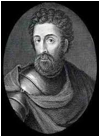 William Wallace. Battle of Roslin, of the First War of Scottish Independence. Appears the Abernethy has as good a claim as any.
William Wallace. Battle of Roslin, of the First War of Scottish Independence. Appears the Abernethy has as good a claim as any.
(Rosslyn is also a neighborhood in Arlington Virginia.)
 Sinclair Motto: COMMIT THY WORK TO GOD.Badge: furze (whin) or white clover Chief: Malcolm Ian Sinclair, 20th Earl of Caithness
Sinclair Motto: COMMIT THY WORK TO GOD.Badge: furze (whin) or white clover Chief: Malcolm Ian Sinclair, 20th Earl of Caithness
Crest: A cock Proper, armed and beaked Or.
1391 William de Cochrane, And being in great favour with King Robert III, obtained from that prince, for his good and faithful ‘services’, an annuity of forty fillings sterling, out of the profits of the borgh of Raglene, dated the 24th day of February, 1391. About this time, there was one Gilbertus de Cochrane, witnefs to a charter of Duncan earl of Lenox, to fir Robert Kennedy of Dunnure, dated anno 1391, suppofed to be the brother of William, but we can give no account of his pofterity. William died in the beginning of 1392 and left a son.
Robert de Cochrane dominus efnfd, who fucceeded him, and immediately upon his father’s death, fold his barony of Long-newton, which appears by charter of vendition of these lands, to Sir Henry Douglas of Lochleven, from Robert, fon and heir of William de Cochrane, dated anno 1392. He lived to a great age, died about 1450, and was succeeded by his son,
Alanus de Cochrane, who is witnefs in a charter of a donation, by Robert lord Lyle, to the monks of Paifley, of a fifhing on the river Clyde at Crokatfhot, pro salute anims sue, anno 1452, in which he is designed Alunus de Cochrane, anniger. He got a charter under the great seal of the lands of Grugfate, anno 1468.
1525 The Battle of Pavia. The Garde Écossaise survived until the end of the Bourbon Monarchy as the senior or Scottish Company of the Gardes du Corps (Body Guards). During the reign of Francis I the garde were held up by blizzards near the Simplon Pass after a defeat at the Battle of Pavia in 1525. Some of the men reputedly settled there and their descendants became known as the “Lost Clan”.
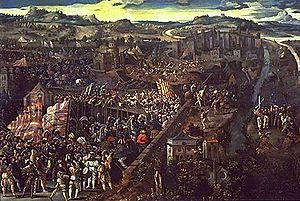 The Battle of Pavia by an unknown Flemish artist (oil on panel, 16th century)
The Battle of Pavia by an unknown Flemish artist (oil on panel, 16th century)
1582 Pope Gregory XIII publishes his plans for calendar reform – the Gregorian Calendar – in a papal bull.
1599 never happened in Scotland. The last 2 and 3/4ths months of 1599 were lost (or disappeared, evaporated) in a redating of the calendar year. Dating its years from the birth of Jesus Christ, so that ‘’ every nation, kindred, every ear shall hear, every knee shall bow, and every tongue shall confess, Jesus Christ is Lord,’’ thru computer software applications and aviation, the Christian calendar has been adopted world wide for the Musselmen of Islam, the Buddhist, Confucian, Hindu, nativist, Jew, agnostic, or atheist (Isaiah 45:23, 1 Kings 19:18, Philippians 2:11, Romans 14:11, confirmed in modern times Mosiah 16:1, 27:31, Doctrine and Covenants 76:110, 88:104.)
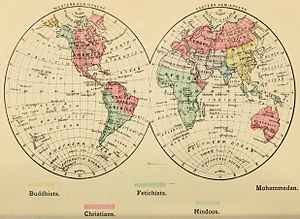 An 1883 map of the world divided into colors representing “Christians, Buddhists, Hindoos, Mohammedans, Fetichists”.
An 1883 map of the world divided into colors representing “Christians, Buddhists, Hindoos, Mohammedans, Fetichists”.
1660 John Murray, 1st Duke of Atholl born KT Knight of the Thistle, PC Privy Counselor, (24 February 1660 – 14 November 1724) was a Scott nobleman, politician, and soldier. John Murray, 1st Marquess of Atholl and his wife, the former Lady Amelia Sophia Stanley. Murray’s maternal grandparents were James Stanley 7th Earl of Derby and the Countess of Derby. John was created 1st Earl of Tullibardine by William III of England (the 3rd after William the Conqueror and William Rufus) in 1696 and was created the 1st Duke of Atholl by Queen Anne in 1703. In 1683 John married Katherine Hamilton, daughter of Anne Hamilton, 3rd Duchess of Hamilton and her husband William Douglas, the Duke of Hamilton, with whom he had six daughters and seven sons; only six children survived into adulthood.
- [Hamilton 2Stewart 2Millar 2simmons 2Choate 2Sorensen]
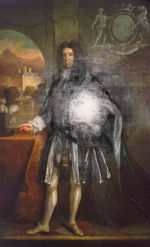 Chancellor of the University of St Andrews John Murray, 1st Duke of Atholl, In 1703 John became Keeper of the Privy Seal of Scotland, and he succeeded his father as 2nd Marquess of Atholl, and in June 1703 John was created Duke of Atholl, Marquess of Tullibardine, Earl of Strathtay and Strathardle, Viscount of Balquhidder, Glenalmond and Glenlyon, and Lord Murray, Balvenie and Gask.
Chancellor of the University of St Andrews John Murray, 1st Duke of Atholl, In 1703 John became Keeper of the Privy Seal of Scotland, and he succeeded his father as 2nd Marquess of Atholl, and in June 1703 John was created Duke of Atholl, Marquess of Tullibardine, Earl of Strathtay and Strathardle, Viscount of Balquhidder, Glenalmond and Glenlyon, and Lord Murray, Balvenie and Gask.
1706 Marquis of Tullibardine (1706) wins the ‘silver arrow’ archery competition. From about 1620 until the 1750s an annual archery competition took place in St Andrews. Organised by the Faculty of Arts, the competition seems to have been restricted to students of the Colleges of St Salvator and St Leonard. The prize for the winner was to have a medal commemorating his victory attached to a silver arrow, which was paraded down to the Bow Butts (archery range) each year for the competition. Each medal is unique, was commissioned and paid for by the winner, and it therefore may reflect his wealth, social standing, fashion consciousness, learning and attitude to the honour. These medals were made by goldsmiths, usually in Edinburgh or Dundee, and represent the work of these craftsmen. In the early 1700s the medals became so extravagant that the University put a limitation in weight (one ounce) and from 1710 the medals all conform to this reduced size. Famous medal winners include key figures from the Civil War period: the future Marquis of Argyll, as Lord Lorne (1623), the ‘great’ Marquis of Montrose (1628) and David Leslie (1626), later Lord Newark.
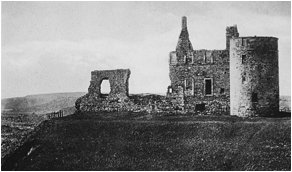 Newark Castle. The Spell of Scotland by Keith Clark, 1916 to the Lord Marischall, Boston The Page Company. P.74.
Newark Castle. The Spell of Scotland by Keith Clark, 1916 to the Lord Marischall, Boston The Page Company. P.74.
There are also some famous Jacobites such as Robertson of Struan (1687), James Bethune of Balfour (1697) and William Murray, Marquis of Tullibardine (1706).
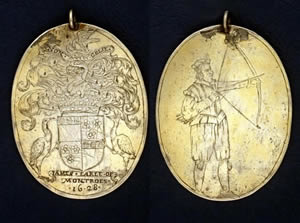 St. Salvator was founded in 1450 by Bishop Kennedy.
St. Salvator was founded in 1450 by Bishop Kennedy.
1716 Earl of Derwentwater and Lord Kenmure executed for High treason for Jacobite rebellion. TG 71-388.`
1721 John Macke died, 1653-1721, born at Inverness, Scotland, descended from a line of clergymen. John emigrated to Salisbury, Massachusetts, in 1669, and then to Lyme, New London, Connecticut. John’s son Ebenezer married Hannah Huntley (clan Huntley), had a son Solomon, 1732-1820, who married Lydia Gates in 1759, and had Lucy Mack, 1775-1856.
Joseph Smith the Prophet, at Fayette, New York. (clan Mack of Inverness, Malcolm King of Scots)
1751 did not occur in England, Ireland, British North America, and British colonies, as 1751 only had 282 days due to the Calendar Act of 1750. But 1751 did occur in Scotland, as 1751 had 365 days. The world’s oldest lunar “calendar” is in an Aberdeenshire field. Led by the University of Birmingham team, excavations of a field at Crathes Castle found a series of 12 pits which appear to mimic the phases of the moon and track lunar months.
1829 Alexander Garden (soldier), (December 4, 1757 – February 24, 1829) War of Independence soldier. MA degree at the University of Glasgow in Scotland in 1779.
1830 Scots Roman Type, prepared in Glasgow Scotland, and shipped to a foundry in Albany New York, then delivered to the E. B. Grandin Printing company in Palmyra New York, according to the Crandall Gutenberg Printing Museum in Provo Utah. The Scots Roman type is the font used to print the first edition of the Book of Mormon. The contract with E. B. Grandin’s print shop to print the book was signed on Tuesday 25 Aug 1829, and the completed book was on sale by Friday 26 March 1830. Typesetter John H. Gilbert selects type and inserts commas, periods, and other punctuation as Gilbert reads Oliver Cowdery’s hand written copy. One form signature of 16 pages, in quantities of 5,000 copies will be printed, 37 signatures, a form per 6 day, 11 hour per day week. Meridian Magazine (14 Apr 2005). http://www.johnpratt.com/items/docs/lds/meridian/2005/printing.html
29th form of 16 pages printed. Somewhere in 3 Nephi.
1834 Joseph Smith the Prophet, at Kirtland, Ohio. (clan Mack of Inverness, Malcolm King of Scots) Doctrine and Covenants 103. All victory and glory is brought to pass unto ye through your diligence, faithfulness, and prayers of faith.
1836 siege at The Alamo Mission San Antonio, Texas Republic (February 23 – March 6, 1836) ends at the Battle of the Alamo on March 6 with list of Scots defenders. Restored in 1847 under the command of U.S. Army Colonel James Harvey Ralston, past Judge of Hancock County Illinois.
1960 Kidnapped. Movie. Fictional Alan Breck Stewart is a Jacobite. Author Robert Louis Balfour Stevenson born 13 November 1850 Edinburgh, Scotland. Stevenson travelled to inspect the family’s engineering works—to Anstruther and Wick in 1868, with his father on his official tour of Orkney and Shetland islands lighthouses in 1869, and for three weeks to the island of Erraid in 1870.
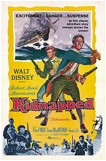 In eighteenth century Scotland, fictional young David Balfour (James MacArthur) is directed by his recently-deceased father’s letter to go to the House of Shaws.
In eighteenth century Scotland, fictional young David Balfour (James MacArthur) is directed by his recently-deceased father’s letter to go to the House of Shaws.
1969 The Prime of Miss Jean Brodie released. Plot set at a School for Girls in 1932 to 1935. Filmed in Edinburgh, Scotland and Cramond, a seaside village on the outskirts of Edinburgh. Film Features include historical references to Flodden Field (1513), Burns’ poetry (1795), Holyrood Palace, and tours of the old mile of Edinburgh’s shops, narrow streets, low buildings, stone walls, and political history (Mary Stuart, Queen of Scots descendants). The characters wander in tours thru Edinburgh, which make the movie original. As the film timelessly captures forever Edinburgh as it may have appeared only 30 years earlier, with buildings from a century before, so it is now nearly a century and a half. Characters have Scots clans names including Mackay, McGregor, McLaren, McPhee, Campbell, McKenzie, Lockhart, and Kerr.
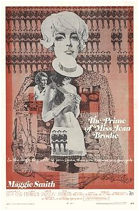 Poster. Young Maggie Smith, dismissed from Marcia Bain School for Girls moves on to another Scot’s private fictional school for Harry Potter’s Hog Warts decades later, as a head mistress, or magician.
Poster. Young Maggie Smith, dismissed from Marcia Bain School for Girls moves on to another Scot’s private fictional school for Harry Potter’s Hog Warts decades later, as a head mistress, or magician.
2000s
 Scrooge (fictional clan McDuck)
Scrooge (fictional clan McDuck)
Disclaimer:
Utah Standard News depends on the support of readers like you.
Good Journalism requires time, expertise, passion and money. We know you appreciate the coverage here. Please help us to continue as an alternative news website by becoming a subscriber or making a donation. To learn more about our subscription options or make a donation, click here.
To Advertise on UtahStandardNews.com, please contact us at: ed@utahstandardnews.com.


Comments - No Responses to “February 24th Scots Book of Days”
Sure is empty down here...